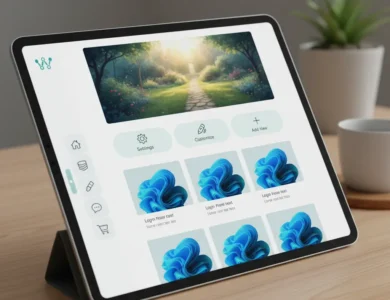Why Hiring an Interior Designer in 2025 Is Smarter Than Ever
Who Is an Interior Designer?
An interior designer is a trained professional who plans, researches, and coordinates interior spaces to make them functional, beautiful, and aligned with client goals. Unlike decorators, designers focus on both aesthetics and structure, working on everything from space layout to material specification.
Roles & Responsibilities
- Space planning and layout optimization
- Selecting colors, lighting, and furnishings
- Coordinating with contractors and vendors
- Budget management and timeline oversight

Who Is an Interior Designer
Interior Designer vs Interior Decorator
While both enhance interiors, decorators focus solely on visuals—paint, furniture, and accessories. Designers also handle structural changes, material specifications, and may require licensing and formal education.
Key Skills of a Successful Interior Designer
Interior design is both art and science. Here are the essential skills:
Creativity
Designers must envision original solutions, blend textures and colors, and create harmony in complex spaces.
Technical Knowledge
Familiarity with building codes, ergonomics, and software tools is crucial for designing practical spaces.
Client Communication
Effective communication ensures the designer captures the client’s vision and manages expectations professionally.
Project Management
Designers juggle timelines, budgets, contractors, and product deliveries—often acting as project leads.
Services Offered by Interior Designers
Residential Design
From cozy studios to grand estates, designers tailor spaces to suit lifestyle, aesthetics, and function.
Commercial Spaces
Designs for offices, shops, and clinics improve workflow, branding, and customer engagement.
Renovation Planning
Interior designers help plan structural modifications, permits, and updates during remodels.
Styling & Staging
They also offer furniture selection, color coordination, and décor styling—perfect for real estate staging or seasonal updates.
Different Types of Interior Designers
Interior design is a broad field with several specializations. Choosing the right type of designer depends on the nature of your project.
Residential Interior Designers
They focus on personal living spaces like homes, apartments, and villas. Projects may include full renovations, new home planning, or single-room makeovers.
Commercial Interior Designers
These professionals design offices, retail stores, restaurants, and shopping malls. They prioritize branding, functionality, and user experience.
Hospitality Interior Designers
Specializing in hotels, resorts, and cafes, these designers blend luxury with comfort to create memorable guest experiences.
Sustainable Design Experts
Eco-conscious designers integrate green materials, energy efficiency, and wellness-focused layouts to reduce environmental impact.
Popular Interior Design Styles
Interior designers often specialize in certain styles or offer customized blends to suit client tastes.
- Modern – Clean lines, neutral palettes, and functional layouts.
- Minimalist – Less is more. Emphasis on space and simplicity.
- Traditional – Rich textures, ornate furniture, and classic motifs.
- Scandinavian – Natural light, wood finishes, and cozy accents.
- Industrial – Exposed beams, concrete finishes, and metallic details.
Designers adapt these styles to suit the space, lifestyle, and purpose.
Steps in the Interior Design Process
Interior design is a structured process aimed at achieving both beauty and usability.
Initial Consultation
Designers meet with clients to understand their needs, style preferences, space functionality, and budget.
Space Planning
Layouts are developed to optimize flow, light, and utility—especially important in small or complex spaces.
Design Development
Mood boards, color schemes, materials, furniture selections, and 3D visuals are presented for feedback.
Execution
Designers coordinate with contractors and suppliers to bring the vision to life, ensuring quality control and on-time delivery.
Tools and Software Used by Interior Designers
Technology plays a huge role in modern interior design.
- AutoCAD: For precise floor plans and layout designs.
- SketchUp: For 3D modeling of interior spaces.
- Revit: Advanced building information modeling (BIM) software.
- Photoshop: For mood boards, textures, and image rendering.
- VR & AR Tools: For immersive walkthroughs and real-time visualization.
These tools help designers communicate ideas clearly and avoid costly mistakes.
How to Choose the Right Interior Designer
Hiring an interior designer is a personal and professional decision. Here’s how to make the right choice:
Portfolio Review
Look for versatility, creativity, and experience in projects similar to yours.
Experience & Credentials
Verify education, certifications (like NCIDQ or CID), and industry affiliations.
Budget Compatibility
Ensure their service fees align with your financial expectations. Ask about pricing structures—hourly vs fixed-rate.
Communication & Chemistry
Your comfort with the designer matters. A good relationship leads to smoother collaboration and better outcomes.
Benefits of Hiring an Interior Designer
Space Optimization
Designers make the most of every inch, ensuring both function and flow are prioritized.
Time & Cost Efficiency
They prevent costly mistakes, reduce trial-and-error, and manage timelines effectively.
Professional Finish
From lighting to linens, designers deliver polished, cohesive, and well-executed interiors that elevate property value.
Interior Designer vs Architect
While both work in design, their roles differ significantly.
| Aspect | Interior Designer | Architect |
|---|---|---|
| Focus | Interior layout, materials, furniture, lighting | Building structure, layout, engineering |
| Education | Degree in Interior Design | Degree in Architecture |
| Licensing | Optional in many regions | Mandatory |
| Collaboration | Often works with architects | May hire interior designers for detailing |
Cost of Hiring an Interior Designer
Interior designer fees vary based on project scope, location, and experience.
Hourly Rates
Ranges between $75–$250/hour, ideal for consultations or small tasks.
Project-Based Fees
Flat fees or percentage of the project cost (5%–20%) are common for comprehensive services.
Cost Factors
- Scope and complexity
- Custom or imported materials
- Location and property type
Budgeting Tips
- Set priorities early
- Ask for a breakdown of design vs implementation costs
- Leave buffer for unexpected changes
Interior Design Trends in 2025
Interior design is ever-evolving. Here are key trends dominating the industry in 2025:
Biophilic Design
Nature-focused design using indoor plants, natural light, and organic textures to enhance wellness.
Smart Homes
Integration of voice assistants, automated lighting, and intelligent appliances for modern living.
Sustainable Materials
Eco-friendly choices like cork, recycled metal, reclaimed wood, and low-VOC finishes are on the rise.
Personalized Spaces
Customized layouts and décor that reflect the owner’s lifestyle, values, and story are more important than trends.
Challenges Faced by Interior Designers
Client Expectations
Sometimes unrealistic expectations can lead to misunderstandings. Clear communication and mood boards help bridge the gap.
Budget Constraints
Balancing quality and design within a tight budget requires creativity and resourcefulness.
Supplier Coordination
Timely delivery and quality control of materials can be challenging, especially with global logistics issues.
Interior Designer Certifications and Education
Degree Requirements
Most professional designers hold a Bachelor’s Degree in Interior Design or a related field.
Licensing
Depending on the country or state, licensing may be required. In the U.S., NCIDQ certification is widely recognized.
Industry Certifications
- CID (Certified Interior Designer)
- LEED Accredited Professional for green design
- WELL Certification for wellness-oriented interiors
Case Studies: Interior Designers in Action
Home Renovation
A dated 1970s apartment was transformed with a Scandinavian theme—white walls, light wood flooring, and space-saving furniture. The result? A modern, airy living space and increased property value.
Office Transformation
A tech startup hired an interior designer to create a collaborative workspace. Acoustic panels, ergonomic furniture, and brand-inspired colors enhanced both aesthetics and productivity.
Hotel Design Project
An eco-resort worked with a sustainable interior designer to create villas using bamboo, local textiles, and solar-powered lighting—boosting its appeal to eco-tourists.
Frequently Asked Questions About Interior Designers
1. Do I need an interior designer or just a decorator?
If you want to change structure or layout, go with a designer. If it’s just furniture and color, a decorator may suffice.
2. Can interior designers work remotely?
Yes, many offer online consultations and remote project management services.
3. Are interior designers worth the cost?
Absolutely—designers save time, prevent costly errors, and enhance space functionality and property value.
4. What should I prepare before hiring a designer?
Have a clear budget, inspiration images, and a list of must-haves and deal-breakers.
5. How long does an interior design project take?
Projects can range from 2 weeks (styling) to 6 months or more (full renovations).
6. Can interior designers help with permits and approvals?
Yes, many assist with local regulations, contractor coordination, and documentation.
Hiring an interior designer is a smart investment that blends creativity, functionality, and strategy. Whether you’re redesigning your living room, transforming a retail store, or building a wellness retreat, a professional designer ensures every element works in harmony. In 2025, as trends evolve and technologies emerge, partnering with a skilled interior designer isn’t just an upgrade—it’s a necessity for creating spaces that truly reflect your vision and lifestyle.





